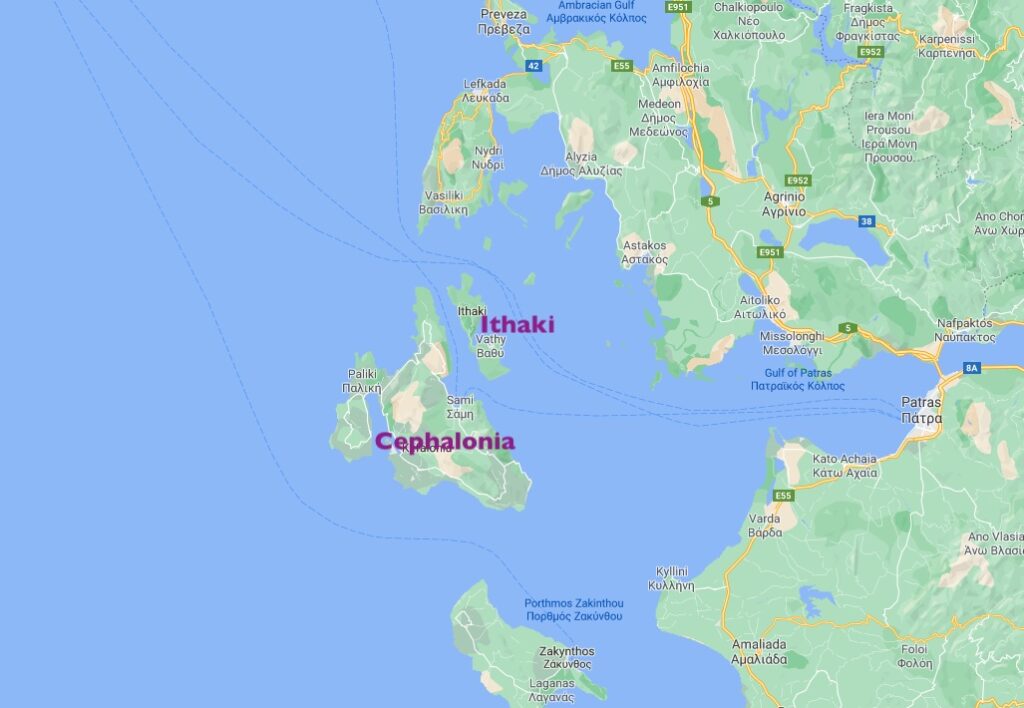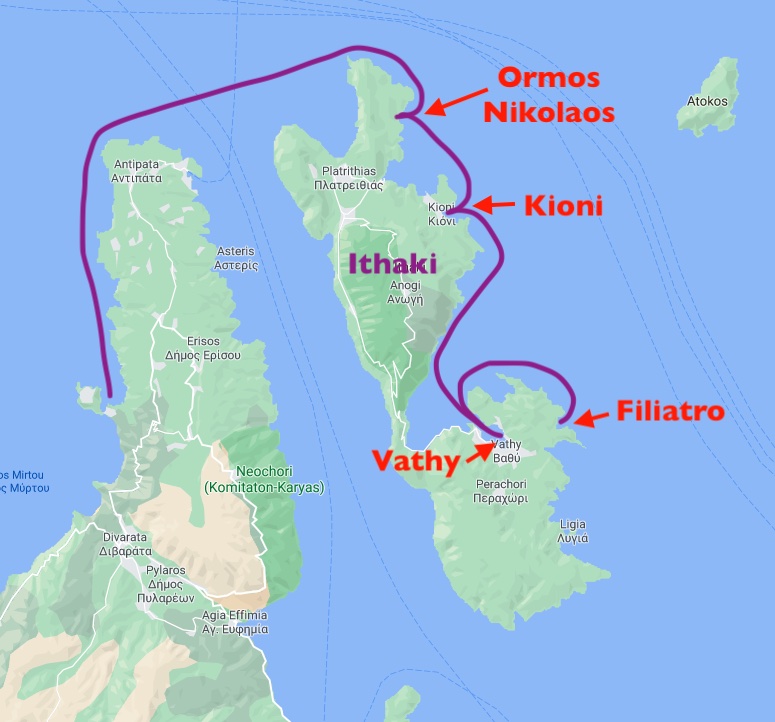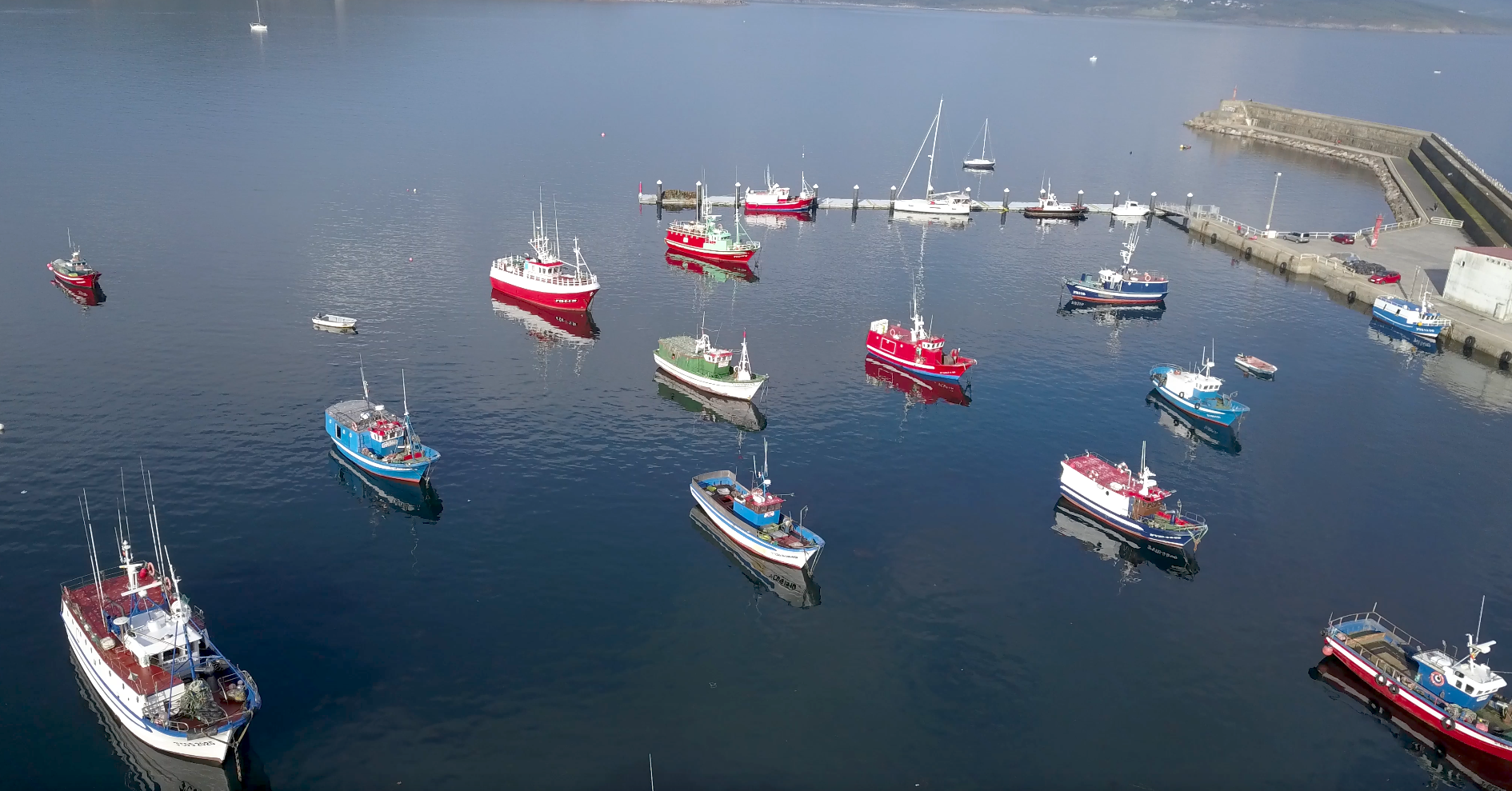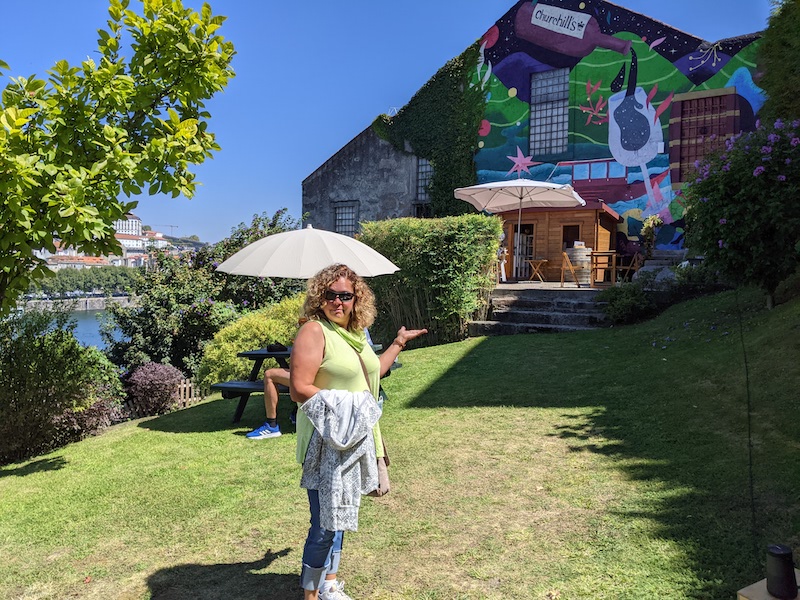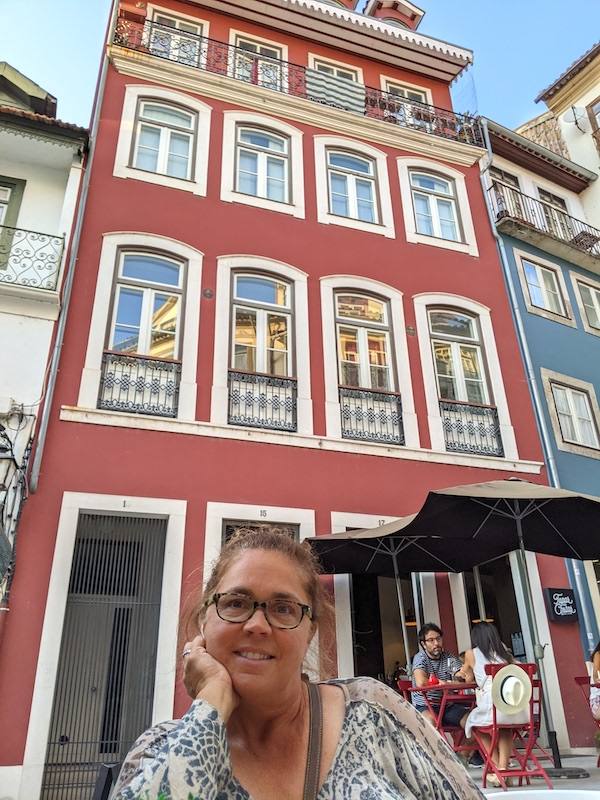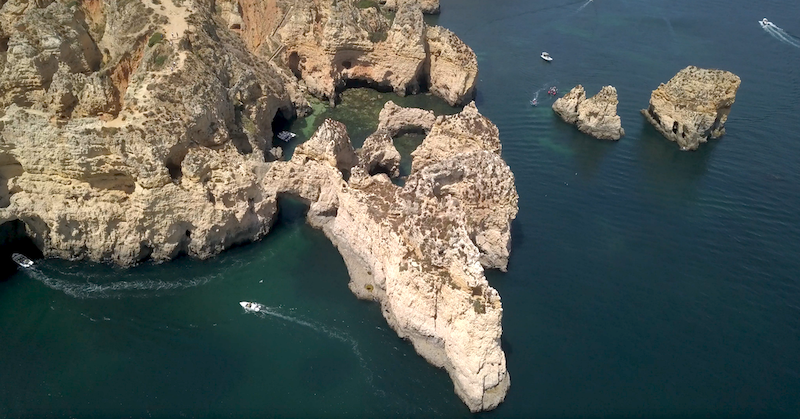Ever get that feeling that you are spinning your wheels? Like, as much as you try, you can’t move forward? We had just finished our Covid bubble embraces with Dan, Don and Shelly at Portosin. It was time for our last big push before our haulout in a week. The sky was dark and threatening to rain, but we needed to make progress. We shoved off the dock at the Real Club Nautico. As lines and fenders were getting stowed in lockers, we quickly got stopped in our tracks. A row of floats had been placed across the harbor entrance. At the far end, a skiff with several people plus a diver were busy handling lines and moving equipment. At the same time, I noticed a distant voice on the breakwater yelling and waving their hands. Were they trying to get our attention? As we approached closer, it was clear there was a line on the surface strung between the floats, blocking any vessel movement. At the skiff end, a narrow gap remained with barely a single boat’s width between them and craggy concrete forms angling down into the depths from the breakwater. Karen got on the VHF radio and tried to call them. I did my best to send a confused hand signal to them. Instead, they started motioning us to run the gap. There was no way we’d have any part of that. First, the diver was randomly disappearing from the surface, presumably to the sea floor. Where he would surface next was anyone’s guess. Second, we didn’t know the depth so close against the breakwater. The whole situation was appalling. Here was a harbor with at least 50 pleasure boats, and possibly as many commercial fishing boats, including several deep sea craft, and these guys were blocking essentially any movement in and out. The yeller onshore kept up his antics, and the skiff boys continued to insist there was enough width and depth. Regardless, we knew one thing for sure. If we ran aground or, worse, struck a diver, it wouldn’t matter what some bystanders said was safe. It would be our neck on the line. Another local fishermen was speeding back into the harbor, up on a plane, and nearly struck the float line before being waved off. Finally, we were able to reach the marina on the radio. They sent one of their launches out to meet us, talk to the skiff people, and get them to move their gear over so we could safely exit the harbor. We never found out what they were fishing for. I’m all for supporting a person busily putting fish on the table at home, but I draw the line when they put others at risk and cause a navigational hazard.
Continue reading “Good Vibes, Ep. 173”Bank Deposits, Ep. 172
I will be the first person to admit that we are extremely fortunate to partake in a lifestyle of our own choosing. While Karen and I worked very hard throughout our careers, watched our spending carefully and put a lot of our own sweat equity into projects instead of paying someone else, we owe our good fortune in this last quartile of our life to many people and events outside of our control. And to simple bum luck. I remember a late night drive home many years ago, nodding off long enough to cross the median and waking up just in time to pull out of the way of oncoming traffic. All those diapers my Mom changed, the shuttling to soccer and baseball practices, the fresh baked cakes for my birthdays – all of that could have been for not if I had awoken a split second later. We all have these inflection points in our timeline of life – tectonic, primal, retrospective. Karen and I had a very good friend develop cancer 15 years ago. She was fantastically athletic, her (and our) kids were still quite young, she looked like the picture of health – it did not make any sense. These landmark events can drive focus and block out the noise. Left with a clear signal, this is when I believe we can gain back control in our lives. For me, the signal was crystal clear. Our kids were getting older, my aptitude at navigating corporate politics was waning, my Dad had just passed, our nest egg was secure, and my health, while not as stellar as Emmy’s, was the best it had ever been. So I quit. And eventually so did Karen. We purposely didn’t call it retirement. I have always resisted labels as they quickly lead to stereotypes and, with them, dwindling opportunities to be the unique person that is you. Instead, we called it a sabbatical. But people still inquire, directly or subtly, what we do for work. You don’t fully comprehend what an identity center “work” is until you stop working. To be fair, for some, their work is their identity and for good reason. They are masters of their craft and their identity is rightfully intertwined with their work achievements. There are the Nobel Laureates, but also a good many grade school teachers, fire fighters, car mechanics, family counselors, doctors, etc.
Continue reading “Bank Deposits, Ep. 172”Friendship and Foot Travel, Ep. 171
How does a highly social species such as ours social distance from each other? As it turns out, not very well. You don’t need to be a sociologist to realize that with few exceptions, we thrive on the company of other human beings. Over 80% of the U.S. population lives in an urban area, and the trend is steadily increasing. On the prairies of early American settlement, we would flock to the saloon, the church, the school to share stories and re-invigorate our spirit. It’s why today we collect in corner cafes, on park benches, at the water cooler. It’s no wonder that solitary confinement is a form of human punishment. Would a rock concert be as fun if you were standing alone in the audience? It’s no surprise that we don’t take well to distancing ourselves. Karen and I often chide each other that while it’s been great to be with the one you love through the last two pandemic summers, we greatly miss the company of friends and family.
Continue reading “Friendship and Foot Travel, Ep. 171”Everyday Commerce, Ep. 170
Table wine has to be one of those all time great pleasures of adulthood. It goes magically well with all sorts of food. It can be enjoyed by itself or with a variety of cheeses. By its very nature, it encourages you to slow down and enjoy the moment and the conversation with friends. It’s a porthole into the local culture of a distant land. It can transport us back to a simpler time of ox carts, oak barrels, and eating al fresco style at a long wooden table with family. It carries with it all of the romance and practicality of farm-to-table dining. My parents would enjoy a glass of wine most nights with dinner, and so it wasn’t a surprise for me to imbibe as an adult, especially as Karen and I started to explore our local Northern California surroundings. But then one day a friend put a glass of Port in front of me and I ran for the hills. It was like a first taste of beer or wine. You nearly gag on the stuff and wonder what the fuss is all about. By the time Karen and I sailed Sea Rose into the harbor of Porto, I had moved beyond the gagging stage, and had a relatively neutral relationship with the wine derivative. Yet, few people come to Porto and walk away with an unaltered view of the nectar.
You have to be careful not to overindulge, and on a hot summer day it’s difficult to resist picturing any liquid as a refreshment. Karen had booked two Port tastings during our visit, and we set out tromping through the narrow streets and across an iconic iron-girded bridge to the other side of the Douro river, technically not part of Porto proper, where all of the Port houses were located.


Our first stop was Calum. There are a number of prominent options next door to each other, with vast tasting rooms and comprehensive cellar tours conducted in multiple languages by well-appointed guides. Calum was clearly corporate money, run on a schedule that vied for Swiss-watch accuracy. This was no family run affair with grandpa coming out of the vineyard on his aging John Deere to balance greeting you and chasing away the chickens and barn dogs. Not that corporate was all that bad. Instead of siting on hay bales, we sunk into an ultra soft couch in a converted stone-arched interpretative center and alternated between Port varietals and extra orders of chilled water. Jet-setting 20-something Europeans had to weigh sitting on a couch too-close-for-Covid with an American couple, or hustle along to the next house. We were not prepared for the distractions of an air-conditioned tasting room, and soon found ourselves hustling along as well for our next appointment, along side streets and past noisy construction sites. When it was clear we weren’t going to make it to Graham’s Port Lodge in time, we stopped to catch our breath in front of a small sign marking Churchill’s Garden Bar. We had stumbled into a garden oasis with terraced orchards descending to the river, coincidentally run by a family member of Graham’s that had decided to strike out on his own. No nepotism for this gent, apparently! It’s hard not to like a disruptive entrepreneur. And it was hard not to like Ports ranging from rubys, tawnys, and rosés in the shade of an orchard, close enough but separate from the hub-bub of downtown Porto.
We weren’t the first to discover this oasis, as a tour bus soon pulled up outside and we were politely reminded of our agreement not to monopolize the picnic table all afternoon. It was a good thing, as a post Port tasting siesta was dangerously approaching. Along the waterfront back in town, replicas of the traditional old wooden boats called rabelas were lined up properly along the river bank as if they were still waiting to use the wind and current to run wine barrels up and down the river as they used to do as far back as the 10th century until mankind threw a curve ball by introducing dams and locks along the Douro in the 1970’s.

But Porto is much more than a city plying its Port trade. If you can manage the sometimes precipitous street climbing reminiscent of Lisbon or San Francisco, you are rewarded with such gems as the Santo Ildefonso Church, with a tiled exterior shout out to the Baroque era. Nestled in between all of the cathedrals and plazas are street musicians serenading you along the way to a tempting potpourri of restaurants ready to re-energize you for the start of part two of the European day, which commences with dinner anywhere from 8-10pm. Alas, Karen and I had an early start in the morning; we’d have to trust the 20-somethings to carry the torch for us.

The tide was scheduled to turn in our favor and hit peak ebb at daybreak, giving us plenty of incentive to raise the anchor and be on our way, as we pushed north out of Portugal. We were bound for the Spanish region of Galicia, occupying a little time-out style corner of Spain in the extreme northwest of the Iberian peninsula. Most people think of Spain’s prominent cities – Madrid, Barcelona, Valencia – but tucked away in this corner just north of Portugal is Galicia where we were told several extensive river systems ran deep into the interior, providing tantalizing protection from the tempestuous Atlantic. We had developed an expectedly deep fondness for Portugal, a country that holds its charms close, almost secretively, unlike the big bullhorns of Mykonos, Ibiza, and the Amalfi. Jutting out into the Atlantic as it does, we would without a doubt be back.

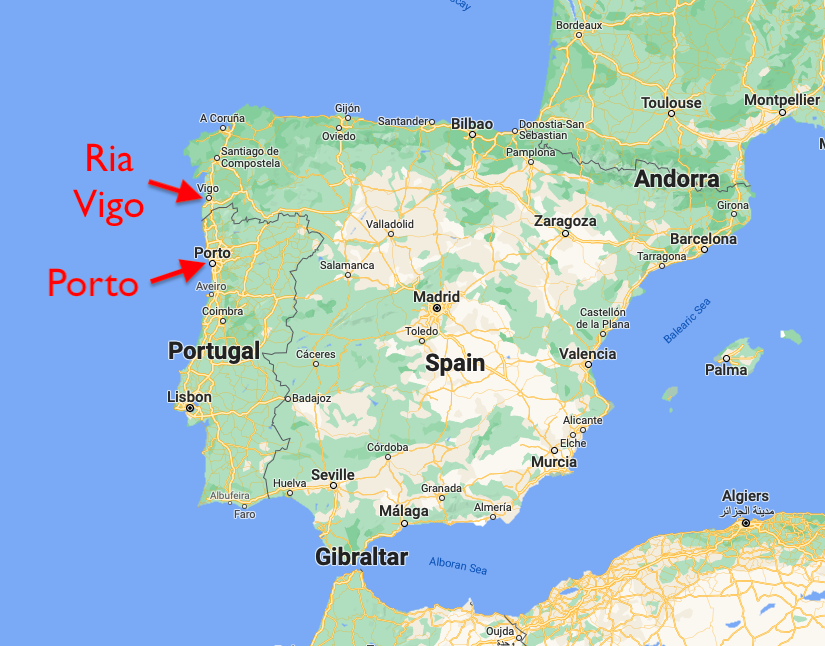

After being flushed out of the Douro River, we had 70 miles in front of us before reaching the first of the Galicia rivers, named Ria Vigo, a distance well within our wheelhouse after our earlier long strides up the coast. After passing the industrial port of Lexioes, with refineries juxtaposed with the fading charms of Porto in the distance, a light breeze developed from astern, tempting us to set our sails. But this rugged Portuguese coast with a reputation full of nasty weather had yet to lash out at us. Only a steady long-period swell rolling in from offshore reminded us we were no longer in the Med. OK, and also the clouds and threatening rain. The Galicia region, along with the northern Spanish coast stretching east to France, is nicknamed Green Spain for a climate that is closer to Ireland and the UK than the more well known arid interior of Spain. Warm moist air blowing in from the Atlantic is halted by a ridge of tall mountains, leading to lush pasture lands and thick forests. Our indoctrination into Northern European weather would be kicking into gear shortly!
Our first stop on the doorstep of the Ria Vigo was the village of Baiona. In our style of sailing, where we are moving steadily and trying to see as much of this beautiful planet as we can in our remaining time on earth, every once in awhile you need a utility stop, and Baiona seemed like the ideal option. A large anchorage in shallow water protected by a long breakwater – with grocery, chandlery and self-serve laundry ashore – checked all of the boxes. By the end of the day, with the errands necessary to keep a cruising sailboat and crew shipshape completed, we peeled back a layer of this understated town to better educate and enrich our Galicia introduction. The Pinta, from Columbus’ fleet, returned to Baiona in 1493 and became the first ship with news of the American discovery. To be fair, it’s widely understood Columbus didn’t discover America, but more accurately introduced Europeans to the American continent. Vikings sailed across, and before them, migrants from Asia traversed the Bering Strait. In modern times, we made our own discovery in the evening, as we searched for a warm meal after a day of dinghying back and forth to shore in the persistent rain. Baiona was not a town to flash its wares along the waterfront. Visitors, the town seemed to insist, had to show more gumption. We discovered our prize hidden a block off the main drag down an alley only wide enough for pedestrians and hand carts – a treasure trove of tiny cafes and bars. It’s possible this place was overrun with tourists in July and August, but on this drizzly September weeknight, locals shook hands or shared hugs with the proprietor before saddling up to a high top, next to others that found comfort in their espresso, cigarette and furry friend at their feet. I will never grow tired of the small outdoor European cafe scene. With an entry fee as low as a euro or two, you are welcomed into a social embrace whose dimensions of time and tenor are entirely of one’s own choosing.
As we exited the anchorage the next morning, we couldn’t help noticing the wide variety of northern European flags flying from boats surrounding us. Heading into the northern latitudes at this late hour of summer, we didn’t know what to expect for boating company. If Portugal had been any indication, it would be pretty light. Yet here we were in the company of Swedish, Danish, German, British, French and one Norwegian boat. With the rain, and the lack of tavernas ashore, it wasn’t quite the social scene we had left behind in the Med, but it was reassuring to know we were not alone. A few boats also flew a similar flag on their port spreader, which we found out later was the Atlantic Rally for Cruisers (ARC) rally flag. This crossing of the Atlantic wasn’t set to start for another two months, but apparently people were taking extra time to explore on the way south to the rally’s starting point in the Canary Islands, or maybe they had had enough of the cold and wet of the north.
Our friends Eric and Rhonda would be joining us in a few days and we felt the need to start checking out the various Ria Vigo anchorages to optimize their time onboard. Pre-covid, Karen and I would regularly have guests onboard – life is so much richer with friends to share in the journey – but we do find socializing and daily trip planning to be at odds with each other. The visit tends to go smoother if we have pre-planned a rough itinerary and identified multiple options for overnight locations based on a variety of weather scenarios.
Along the northern shore of the Ria Vigo are a string of small anchorages with long beaches to entice one to swim and explore with their benignly ankle-high wavelets coming to rest gently on the sand. The first, Enseada da Barra, is tucked behind a headland, protecting it from the steady ocean swells that seem to work past islands and peninsulas here with every intention of rolling your boat from side to side and keeping you up all night. It wasn’t hard to find Enseada da Barra, as the headland had not one but four lighthouses marking its approach from the sea. Talk about redundancy!



We had been tipped off by other boaters that the Rias supported a robust muscle farming industry with numerous floating platforms anchored to the seafloor, making it challenging to navigate around them. These floating farms, called viveros, were indeed sprinkled along the near shore areas, and we approached as close as we safely could to examine them. But they did not impede our ability to navigate nor to enjoy the safety of these waters. Consequently, muscles are served at nearly all of the local restaurants, and we didn’t feel it was our place to criticize an industry that featured so prominently in the local economy with a menu item we would regularly order and enjoy locally. Here was a food offering that, unlike land-based farms that sometimes damaged the nearby sea life with fertilizer runoff, actually worked to positively clean the water with their filter-feeding physiology.

We settled for the night in the adjacent and curiously named harbor of Cangas with its own long sandy beach, tucked in behind a large muscle farm which helped to calm the seas even further. With so much muscle farming going on, and coastal waters rich in seafood, Cangas had its fair share of commercial fishing operations ashore. Yet like so many small towns in this region, work and pleasure seemed to easily co-existed, even thriving on each other. As a visiting tourist, there is a certain groundedness that comes with hearing the sounds and seeing the sights of day-to-day commerce in and amongst the shops and restaurants. I would like to also think that fishermen and women also prefer a bustling, local waterfront full of eager souls ready to order their fresh harvested seafood at local restaurants and grocery stores.

In the morning, we were up early to hop across to the namesake of this ria, the city of Vigo. Eric and Rhonda would be arriving later in the day, and the pre-arrival check list was growing rapidly. It was clear even before we approached the Vigo waterfront that commerce was priority one in this town. Massive working docks lined the shore. On one end, multiple car carriers tied up adjacent to a massive parking lot crammed with thousands of new passenger cars waiting for export. In the center of the waterfront were rows of dry docks and shipyards servicing large commercial fishing, research and tug boats. Next to them were a series of big refrigerated warehouses owned by Pescanova, one of the largest fishing companies in the world and the center of the Galicia canned fish industry. Finally, several tall container cranes loomed over the opposite end of the waterfront. For obvious reasons, we sought out a quieter alternative to overnight onboard Sea Rose, settling on Marina Punta Lagoa, nestled into a wooded knoll on the outskirts of town. The marina had plenty of space for us, with wide long docks and stout cleats. Our only challenge was on the communications front. We had been told to not expect much English in the Galicia region, and that was a very spot-on warning. No one answered our VHF call, and when a friendly man arrived by skiff to greet us, we got by with simple nods and hand gestures. Our usual list of questions on where to get fuel, buy groceries, do laundry, and eat out would have to wait for another time.

Even if we had been able to communicate, it wouldn’t have changed our odds of finding an open store on this Sunday. Our best option seemed to be back in downtown Vigo. Not wanting to rely on hand gestures with a taxi driver, even if one could be found on this day, we took Option B of lowering the dinghy and motoring across the harbor. A city of industry is not a tantalizing affair on a Sunday and Vigo was no exception. We settled on the first convenience store we could find that was open, with packaged meats of unknown expiration but the upside of fresh baked bread. Otherwise, Vigo looked like a city who had lost its tourism director after a few abandoned false starts along the waterfront. Still, our first glimpse of the Spanish Rias teased us with their lightly frequented beaches, curvaceous offshore islands, and the fortitude of commerce to lay before us the tasty bounty of the sea. We were on the cusp of a whole new adventure in this secret corner of Spain.

Gift Giving, Ep. 169
It seemed too good to be true. Ahead of us was the unforgiving coastline of Atlantic Portugal with its steep cliffs and deep ocean canyons. Yet for the next six days, the forecast was one of mild-mannered seas and gently cooling evenings. The notorious Nortada, the wind from the north that had us double checking the diesel in our tanks in order to brutally bash our way to windward, seemed to have left on vacation. Like the angelic girl of your high school dreams, momentarily still available to join you on the dance floor, timing was critical. Fresh from our land pursuits, we hopped back onboard Sea Rose and exited Marina de Cascais, pointing our bow almost exactly north on the ship’s compass to the first safe harbor of Peniche. We didn’t want to show any disrespect to the weather gods for handing us this unexpected gift.
It didn’t take long before Cabo da Roca, that westernmost point of continental Europe that we had seen by car, to first come into view. My worries about the treacherous rock-strewn shoreline full of whipped up white water were all for naught. You could practically water ski on these benign ocean scapes.

Portugal by Land – Bring Your Climbing Legs! Ep. 168
Before Karen and I dove deep into the sailing life, we’d frequently jump in the car and take to the road. Our adventures took us to stunning vistas in California’s Sierra Nevada, the Pacific Northwest, and all throughout the Northeast of the U.S. As beautiful as these excursions were, I’d find myself yearning to eventually find a watery overlook – sea cliffs, a lake, even just a mountain stream. There is something mystifying and transformative about the water. The sound it makes over pebbles or beach stones has the power to settle the most anxious mind. Sitting at the ocean’s edge, the water serves as a portal to another world; floating across the sea, there is nothing separating you from experiencing an entirely different culture and geography – whether you go there or it comes to you. On a road trip, I love these context switches.
Similarly, as much as we cherish our adventures at sea, full-time life onboard can at times feel a bit monochromatic. So, every once in awhile, we park the boat and head inland. With the long, skinny geography of Portugal, it is hard to go too far away from the sea, but still there are a lot of fantastic sites to visit.
Continue reading “Portugal by Land – Bring Your Climbing Legs! Ep. 168”Clear Air and Cosmopolitan Charm, Ep. 167
The anchorage at Sagres, with its semi-circular beach, felt like one of those fancy curved-back love seats, the ones with the high armrests. To each side of us was high protective cliffs, the water around us had soft little ripples like corduroy, as the wind blew gently off-shore, keeping the surface free of swells. Tomorrow’s forecast to tackle the west coast of Portugal looked even better than today’s, so we took it easy exploring this mariner’s outpost. At the point of land, a grand lighthouse stood watch over the tall headlands, making for a long range of light out to sea. Around its perimeter were the renovated remains of the 18th century Fortress of Sagres. It was flat as a pancake on the top of these headlands, with built in protection on three sides with the sheer cliff drop off. The designers only had to take into account a secure wall across the narrow land entrance.

What the Tide Bringeth, the Tide Taketh Away, Ep. 166
The Ria Formosa lagoon was so expansive, it felt like we were anchored on an inland lake, a lake with just a few hundred of our sailing brethren. Once we had backed down on our anchor and ensured that it was going to hold our floating home securely, I launched one of the paddle boards and started exploring around the anchorage. It quickly became apparent that despite being inland, the waters here were too chopped up to make paddle boarding safe, let alone enjoyable. It seemed like a constant line of high speed taxi boats were running from the ferry landing to the mainland, back and forth with reckless abandon. Before I embarrassed myself with a wobbly, on-a-constant-threshold-of-falling paddling experience, we opted to dinghy into shore and check out the scene on Culatra.

Crossing Borders and Bars, Ep. 165
With the warm Atlantic waters lapping at its door step, no city quite captures the essence of southern Spain like Cadiz. Aromas waft up from sidewalk-busting cafes leading to hundred year old trees shading cozy neighborhood squares. Majestic coastal fortifications once built to ward off marauding intruders now wrap pedestrians in a warm embrace, perched as they are high above the din of the city. Residents and Spanish tourists alike walk as if guided by deeply embedded cultural cues, as they seek out the most direct path to a siesta sponsored beach afternoon, towel and umbrella in tow.
I recognized very little of a city my parents insisted we visit on a quick vacation to Spain many decades ago. With only a handful of years under my belt, I remembered the name Cadiz, but painfully little else. Such is the curse of family trips with young children. Paradoxically, we struggle to remember now, cursed as our brains are with little room to store a lifetime of memories.
Continue reading “Crossing Borders and Bars, Ep. 165”Old Friends and Olive Trees, Ep. 143
Let’s get one thing out of the way at the beginning. There is a particular island in the Ionian, Ithaki, that is not pronounced like you think it would be. It is ‘ehh-TALK-yy’. This came as troubling news to Karen, growing up as she did next door to Ithaca, NY, where natives would think you were from another planet if you didn’t say ‘ITH-a-kuh’. We had the good fortune of a Greek native with us, Theo, to break the news gently. There you go. Now we are ready to move on.
As we rounded the northern tip of Cephalonia on our eastward leg to the neighboring island of Ithaki, the winds started to build, just as they had been forecasted. We started off with both sails fully set, sending us gently along at a speed, because it is less than one could motor at, that can make one twitchy if there’s a long distance to go. Theo, just inshore of us, had a little less wind and more tonnage to move through the water, leading him to keep motoring. We soon had a bonafide breeze of 15 knots, cause enough to begin thinking about a plan to reef, as we skimmed across the water on a glorious downwind angle. The forecast called for higher winds into the evening and possibly over the next few days, so we sought protection on the eastern shore of Ithaki, with our first stop at the little cove of Ormos Nikolaos. Ormos means bay in Greek, but there was nothing expansive here on the scale of San Francisco Bay or the Bay of Biscay. I will be filing for a name change to Limanaki Nikolaos, as soon as I find out who in the Greek government will entertain my request.
